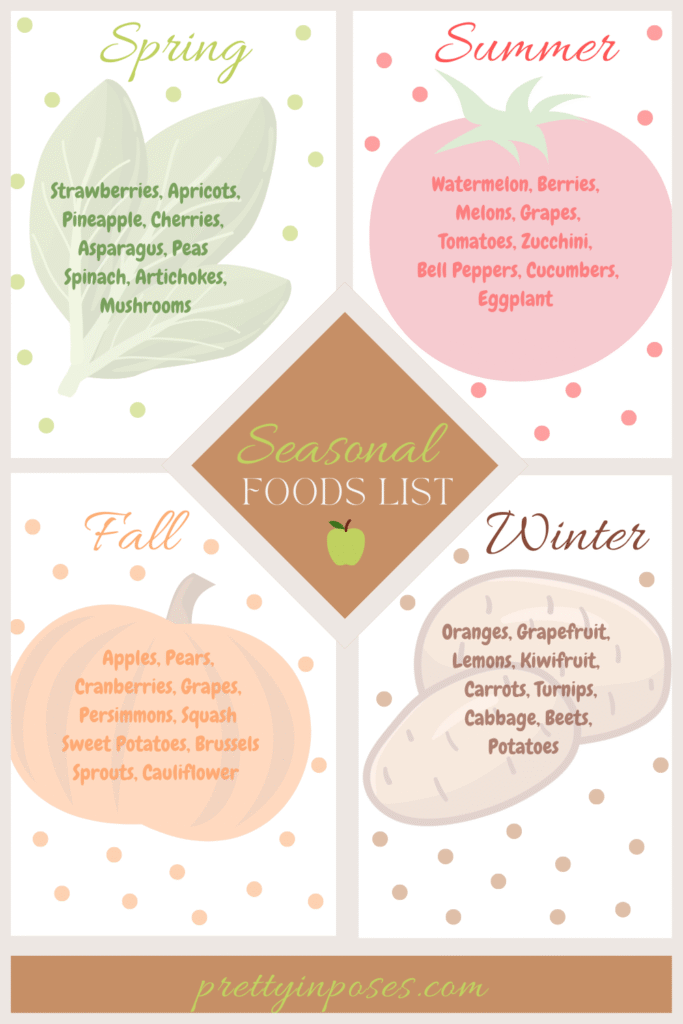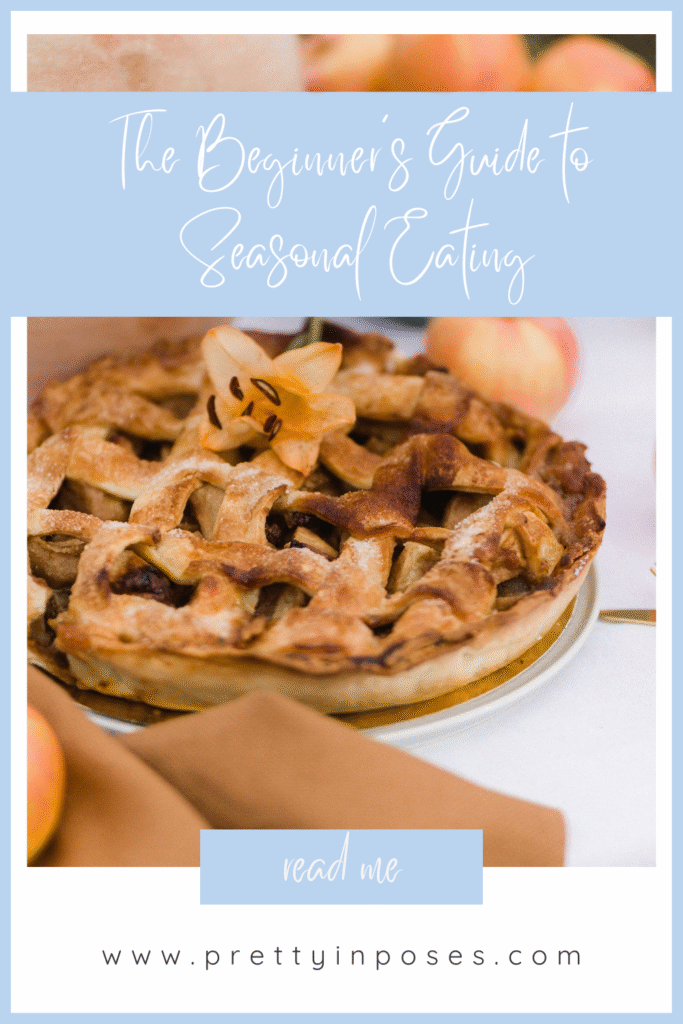This post shares a beginner’s guide to seasonal eating: what to eat and why.
Whenever a new season comes around, I start thinking about making lifestyle changes.
I update my wardrobe, switch up the home decor, and even adjust daily routines to match the time of year.
But I never consider doing the same with food, although there are plenty of benefits to doing so.
In this post, I’ll share a beginner’s guide to seasonal eating. You’ll learn exactly what to eat and why it matters to help you feel your best year-round!
What is Seasonal Eating & Why Do It?
Seasonal eating means enjoying food near the time it was harvested. It’s a practice that’s not only great for your health but also offers economic benefits.
When allowed to ripen naturally, produce tends to be more nutritious and flavorful. It also helps to support your local economy since you’re likely to buy from community farmers.
Another benefit of eating seasonally is that it may reduce your exposure to chemicals and preservatives often used to keep food fresh during long-distance transportation.
How to Choose the Right Seasonal Foods
Each season has unique characteristics that help dictate food choices. Here are some tips to guide you in selecting the right produce as the seasons change.
Spring
Spring is often thought of as a time of renewal and detox. Lighter meals are perfect for this season.
Fresh greens, sprouts, berries, and herbs can rejuvenate the body and boost metabolism after the winter months.
Spring Eating Pro Tip:
Allergens tend to be prevalent during this season, so try to stay away from foods that may exacerbate existing allergies.
This includes dairy products and foods high in histamine. Histamine is a chemical naturally found in the body that plays a role in immune response, cognitive function, and sleep regulation.
High-histamine foods include aged cheese, alcohol, and processed meats.
Summer
Summer is when temperatures reach their peak, and the intense heat can drain the body of energy and moisture.
To stay refreshed, focus on hydrating foods. Watermelon, pineapple, cucumbers, and citrus fruits help replenish fluids and electrolytes, keeping you cool and energized.
Summer Eating Pro Tip:
Since the heat of summer can leave you dehydrated, steer clear of foods that make it worse.
Keep alcohol, sugary foods, and drinks to a minimum, as they can drain fluids from your body and lead to energy crashes in high temperatures.
Also, limit spicy foods, which can raise your body temperature and increase sweating, as well as heavy and greasy foods that can weigh you down in the heat.
Reducing your intake of these foods is always a good idea, but it’s especially important during the summer months.
Fall
Fall is the time of year when temperatures begin to drop. As a result, our bodies start craving warmer, heartier meals in preparation for winter.
Foods like root vegetables, squash, and whole grains are ideal for this season, as they support digestion and help maintain energy levels.
Fall Eating Pro Tip:
In fall, people tend to spend more time indoors due to the cooling weather and upcoming holidays, making it important to limit comfort foods.
Reduce your intake of creamy, heavy dishes like chowders or mac and cheese.
Excess salty processed snacks should also be limited, along with sugary treats like pumpkin pie as they can lead to weight gain and other issues.
Winter
Winter is the coldest time of year, making the body more vulnerable to colds and viruses.
To stay healthy, it’s important to eat warm, nutrient-rich foods that support immune function and help maintain body heat.
Hot meals like soups, stews, healthy fats, and vitamin-rich produce can strengthen immunity and combat seasonal illnesses.
Winter Eating Pro Tip:
When temperatures drop, it’s best to avoid cold foods and drinks, as they can lower body heat and make it harder to stay warm.
Other foods to limit include alcohol and ultra-processed items, which can increase inflammation and weaken the immune system.

How to Eat Seasonally
If you want to begin incorporating seasonal foods into your diet, follow these tips below to help you get started.
Know Your Seasonal Foods
Before you can develop your seasonal meal plan, you must first identify the produce by season. Know what foods you want to include and what time of year they grow.
From there, you can find or create recipes based on these ingredients. Here is a resource to help you accomplish this.
Identify Your Sources
Next, you’ll need to find where to buy the seasonal foods on your list. Look for farmers’ markets in your area that sell locally grown crops, often plucked just days before reaching the stands.
Your neighborhood grocery store may also carry seasonal produce, so make sure to check their selection as well.
Likewise, when fresher options aren’t available, the frozen food section is a great alternative. Many items are frozen at peak ripeness, preserving their flavor and nutrients.
If you prefer, you could even grow your own seasonal foods, though this may require time, space, and materials, making it a more involved option.
Make a Meal Plan
Finally, once you have your list and recipes in hand, you can craft a meal plan that fits your lifestyle.
Remember, learning to eat seasonally may take some adjustment, but with time and persistence, you’ll find it a worthwhile practice.
Eating With the Seasons
Seasonal eating is a great way to support your health while keeping your meals exciting, instead of consuming the same foods over and over again.
Just think of all the fun you can have creating new recipes and meal plans that match the season’s theme, all while diversifying your diet throughout the year.
You could even get the family involved!
With that said, if you have any questions or comments, feel free to leave them below or send me a message on my contact page.
Until next time, happy seasonal eating!







Leave a Reply